With the holiday season quickly approaching, your business needs to take steps to prepare for a potential surge in sales.
But you can’t assume people will buy from your brand during the holidays if you sit back and do nothing. The brands able to recognize the latest marketing trends will have success in the coming months.
Consumers are willing and able to spend money during the holidays. It’s a fact.
How you prepare and position yourself will determine how much of the market share your company will control.
Even though the ecommerce industry is a competitive space, there is plenty of money to go around.
In fact, experts predict ecommerce sales to increase by 17-22% during the 2018 holiday season. November 1st to January 31st is considered the holiday season.
I know what some of you are thinking. There are holidays throughout the entire year. What makes the ones during those dates so special?
Research shows consumers say they will spend nearly $800 during the winter holidays:

On average, they spend more money during the winter holidays than during all the other top-spending holidays combined.
It’s the season of giving, and it’s usually a happy time of year. People are feeling generous when buying gifts for their friends and family.
However, the holiday season can be stressful. The weather starts to get colder. Stores get busier. Consumers feel overwhelmed with the length of their to-do lists.
As a marketer, you need to make the buying process as easy as possible for the customer.
With your ecommerce platform, there is no reason for people to fight the crowds at their local shopping malls. They can buy holiday gifts from the comfort of their homes.
I’ll explain how you can use this situation to your advantage and benefit from a major boost in ecommerce sales during the 2018 holiday season.
Don’t wait to start your promotions
When is it appropriate to start running holiday ads?
Right now.
You need to learn how to build hype for the holiday season as an ecommerce brand.
This is your chance to let people know what to expect. Tell them what type of sales you’ll be running or whether you’re planning to release a new product around that time.
They may not necessarily buy something the first time they see your holiday ad, but be persistent. Continue running promotions on all your distribution channels.
When consumers are ready to buy, your business will be on their minds.
All too often I see ecommerce brands hesitant to start these promotions early. They think it’s a waste of money because people don’t start shopping until late November at the earliest.
But that’s not the case. Research shows that only 27% of consumers don’t purchase any gifts before Thanksgiving:
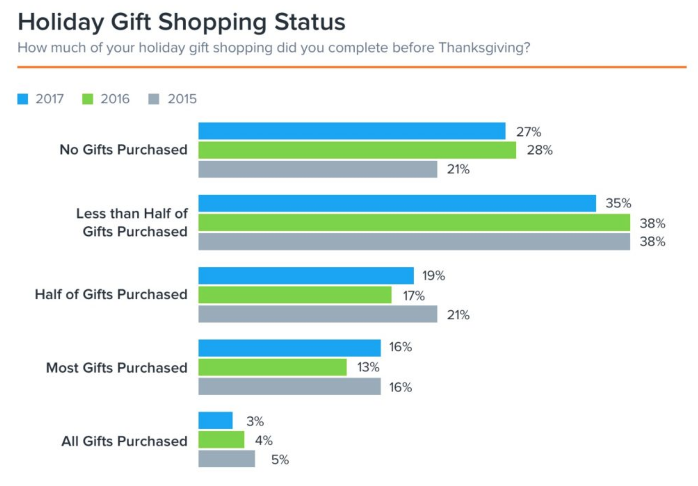
This means that more than 70% of people have done at least some holiday shopping before Thanksgiving.
It’s not unreasonable for a customer to buy gifts during the first week of November.
The earlier you can start your holiday promotions, the greater chance you’ll have of driving more ecommerce sales.
Recognize the most popular shopping days
As you can see, there is a surge in ecommerce sales between November and January. But some days are more popular than others during that time.
Over the past five years, Cyber Monday and Black Friday have consistently been the most popular days for holiday shoppers:
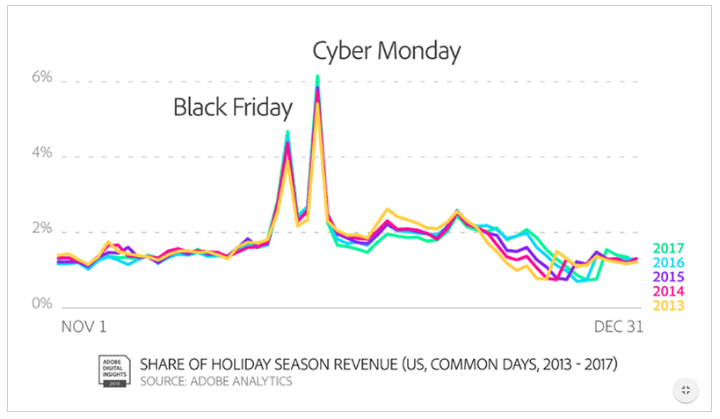
We’ve all seen those crazy Black Friday videos every year. Hundreds of customers running into stores, trampling on anything and anyone who gets in their way.
Six people fist-fighting over the last TV in the store. It’s madness.
Why does this happen? It’s because everyone loves to get a deal.
As an ecommerce brand, you need to run ads promoting ways customers can save money by shopping online. They don’t need to deal with that mayhem to get a bargain.
Here’s another strategy you can consider. There’s no need for you to wait till Cyber Monday to slash your prices.
Since so many people are shopping during those two days, your brand could get lost in the shuffle.
To stand out, create your own brand holiday that same week.
Send out email reminders, post on social media, and update your website. Then your customers will know they can get great deals on the Tuesday or Wednesday before or after Cyber Monday.
If you implement this strategy, you should still continue to run deals on Black Friday and Cyber Monday.
The last thing you want to do is let your competitors steal your customers during the two most popular shopping days of the year.
Put emphasis on your return policy
Obviously, you don’t want to deal with returns. However, your return policy is important to your customers.
This is especially true during the holiday season. When people buy gifts, they don’t know whether the recipient will like what they get.
What if they already have one? What if the size is wrong?
That’s probably why holiday ecommerce return rates are so high.
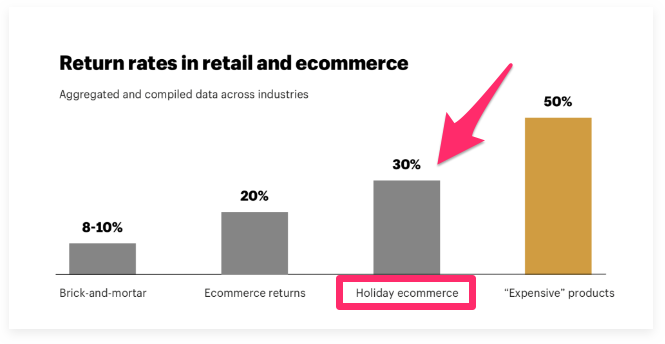
Customers are more than three times as likely to return a holiday ecommerce purchase than a standard brick and mortar purchase.
Ecommerce return rates are 10% higher during the holidays than the rest of the year.
Furthermore, 80% of consumers expect free returns. However, only 25% of retailers have a free return policy.
This is your chance to differentiate yourself from the competition. Offer free returns.
We know that 83% of customers read return policies before buying something, so make sure this information is easy to find on your website.
Here’s something else you should keep in mind: 72% of consumers are willing to shop more frequently and spend more money with businesses offering easy returns.
If you make this process simple, you can boost revenue by optimizing the customer experience.
Consider extending the length of your return deadlines, especially during the holiday season. Here’s why.
Even if your company has a 30-day return policy with no questions asked, it still may not be good enough. What if someone buys a gift for Christmas in early November?
The return policy could be invalid before the recipient even opens their gift.
Take all of this into consideration when you’re creating your return policy. Advertise how easy it is for customers to return gifts without any hassle.
Don’t charge for shipping
In addition to offering free returns, you should offer free shipping as well.
I already discussed how much money people plan to spend during the holidays. They’ll do whatever they can to save money when they have the chance.
If they are torn between buying something from two different brands, they’ll ultimately decide to go with the company that will ship their items free.
Don’t underestimate the importance of this. Free shipping was cited by consumers as the most important option when buying online:

The reason why businesses don’t offer free shipping is because they don’t want the cost to come out of their pockets, which is understandable.
To offset the shipping cost, just raise the prices of your products.
Your customers won’t know the difference. They’re still paying for the advertised price and can benefit from free shipping.
Here’s an analogy.
Have you ever stayed at a hotel offering free breakfast?
Obviously, that breakfast isn’t free. Its cost was included in your nightly rate.
The same concept can be applied to free shipping.
Offer rewards for customer loyalty
The holiday season shouldn’t be a time for you to start focusing on customer acquisition.
Would you be happy with getting new customers? Absolutely.
But that doesn’t mean you should be marketing to a new audience. Instead, focus on generating sales from your existing customers.
These people already know who you are and what you stand for. They’re familiar with your products and don’t need any introduction.
You can increase sales by implementing a customer loyalty program. You can use this strategy all year.
Research indicates 82% of consumers are more likely to buy from brands offering loyalty programs.
If you have these programs in place, make sure you remind your loyal customers they can save money with their rewards during the holidays.
As I said before, people are spending a ton of money during this season, so they’ll gladly look for any way to save a few bucks whenever possible.
During the holidays, 86% of consumers will stay loyal to businesses that have rewards programs:
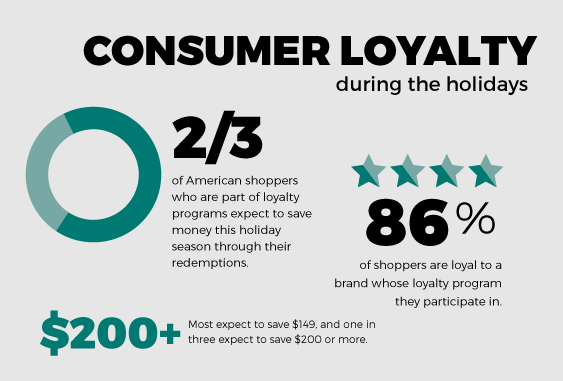
Furthermore, 90% of shoppers say they plan to take advantage of rewards programs during the holiday season.
And 50% of consumers plan to use those rewards to buy more gifts than they normally would.
But just because someone is a member of your rewards program doesn’t mean they won’t buy from another brand.
The average consumer participates in four different rewards programs.
To ensure your customers buy from you instead of your competitors, you need to offer better rewards and incentives.
Make it easy for customers to track shipping
Earlier I mentioned that people are stressed during the holidays.
They have much to do and have many things on their minds. To stay organized, people want the ability to track the progress of their orders.
You should send shipping notifications and tracking numbers to your customers.
This is a great chance for you to create an actionable drip campaign.
First, send an email to the customer confirming their order was completed. Then, send a second email notifying them the order has shipped. This is an appropriate time to include the tracking number.
Finally, send a third email when the product has been delivered.
Click-through rates to tracking pages increase during the holiday season:
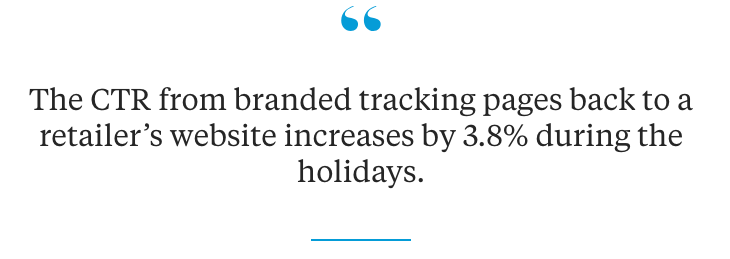
This should tell you that consumers are genuinely interested in tracking their orders. It gives them a chance to make sure everything is going according to schedule.
Studies show 93% of consumers refer to their emails for these notifications, and 38% of people want to be contacted on multiple channels.
If applicable, consider sending text messages and push notifications.
Here is another reason why tracking packages is such an important feature for you to offer.
Statistics indicate that 33% of people have had packages stolen from their doorsteps. Nearly 26 million Americans had packages stolen from their doorsteps or front porches during the 2017 holiday season.
With ecommerce sales expected to rise during the 2018 holiday season, it’s safe to assume theft will rise as well.
These are alarming numbers, but it’s reality. By alerting your customers their orders have been delivered, you can help reduce the chances of theft of their purchases.
Prioritize mobile commerce
By now, I hope you’ve recognized the importance of mobile optimization.
Your website should be mobile friendly, and some of you may have even developed a successful mobile commerce app.
Don’t overlook mobile commerce during the holidays. It should remain an important part of your marketing strategy.
On Black Friday of 2017, 57% of ecommerce traffic came from mobile devices. People were using their smartphones even while shopping in stores.
Mobile commerce held a 37% revenue share last year during the holidays. This was up from 17.5% in 2016.
I expect this trend to continue rising in 2018 and the coming years as well.
Consumers will turn to their mobile devices to buy during the holidays.

As you can see from these numbers, ecommerce brands with mobile apps will have a competitive advantage here.
Make sure you utilize all the features at your disposal.
Send out push notifications to mobile app users to remind them of flash sales. You can also send notifications about order updates, which I discussed when talking about tracking orders.
Appeal to those last-minute shoppers
Earlier I told you that you should start advertising as soon as possible because people start shopping for the holidays sooner than you may think.
But some people just love waiting until the last minute.
Don’t stop running your holiday campaigns until the season is officially over. Make sure you find ways to appeal to last-minute shoppers.
The best way to do this is by offering fast shipping options:
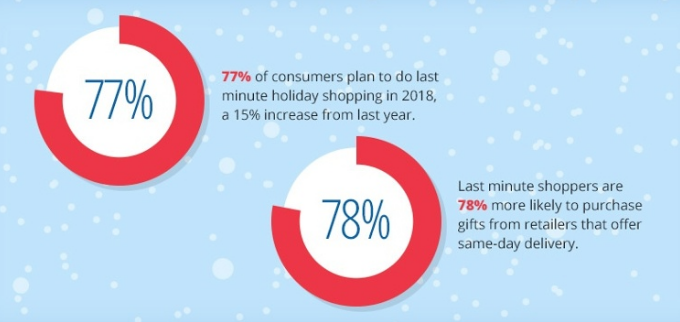
As you can see, people who wait until the last minute to buy gifts are significantly more likely to buy from retailers offering fast delivery.
Last-minute shoppers are 39% more likely to abandon their shopping carts if the delivery options are too slow.
Overall, 67% of consumers abandoned ecommerce shopping carts in the last year because of slow delivery times. This is a 16% increase from last year.
And 92% of consumers said that receiving their delivery on time was the most important factor they considered when purchasing a gift.
Unfortunately, it may not be reasonable to combine your fast delivery feature with your free shipping incentive.
If a last-minute shopper needs something shipped overnight two days before Christmas, they’ll have to pay a premium for shipping. But by this point, they’re willing to pay as long as it arrives on time.
Conclusion
The holiday season is a great opportunity for you to take advantage of consumer spending habits.
Since they spend more money, you have a chance to make more money. But this won’t come automatically.
Start promoting your holiday sales as early as possible. Run your best deals on the most popular shopping days of the year.
Make it appealing for customers to buy from you instead of your competition.
Offer free shipping. Have a hassle-free return policy. Reward your most loyal customers.
Allow your customers to see their order status and track the shipping of their packages.
Don’t forget about mobile customers and last-minute shoppers.
Follow the advice I’ve outlined above, and use this guide as a reference to generate sales during the 2018 holiday season. Happy holidays!
How is your business planning on appealing to holiday shoppers this season?
from Quick Sprout https://ift.tt/2EThawX
via IFTTT
